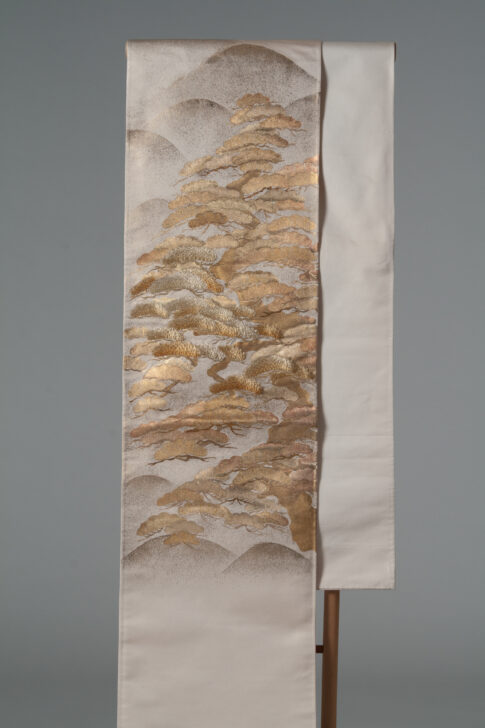Obi
Japanese

Description
Subject Matter:
This is a Nishijin, Nishiki, and Fukuro Obi in Rokutsuu gara.
The landscape consists of stylized silver mountains and gold pine trees.
The pine tree motifs were often used on the robes of princesses in the "Pine on the Shore" or "Crane Nibbling a Pine Branch.” The pine motif were also commonly used for luxurious Nuihaku robes (Noh costumes with designs in embroidery and gold and silver leaf) and for Kosode (kimono with short sleeves) during the Momoyama period (1568-1600) to Edo period (1603 - 1868).
Nishijin-ori textiles were developed in the Nishijin area of Kyoto city and has dominated the production of high-quality woven textiles since the fifteenth century. Nishiki is a type of vibrant silk brocade with vivid and luxurious images using various colorful and metallic (mainly gold and silver). Nishiki brocade is mainly produced in the Nishijin area of Kyoto. Fukuro Obi is double-layered single sided obi in which two separately woven surfaces and back pieces of cloth are stitched together. This type of obi is typically only worn at weddings or other formal occasions. The Rokutsuu gara type derives from a specific tying style, the Otaiko musubi. The areas of the obi that are visible in this style are patterned while the parts that are obscured are left blank. In terms of surface area, roughly sixty percent is patterned while forty percent is left blank.
Physical Description:
Beige Fukuro (double-sided) Obi with an interwoven and painted silver and gold landscape with a with silver and gold embroidery.
Usage Rights:
If you are interested in using an image for a publication, please visit https://umma.umich.edu/request-image/ for more information and to fill out the online Image Rights and Reproductions Request Form.